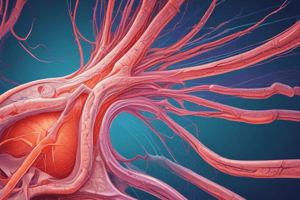Podcast
Questions and Answers
What is the function of the dermis?
What is the function of the dermis?
Provide strength and flexibility, house blood vessels, nerve fibers, hair follicles, glands
Describe the composition of muscle tissue.
Describe the composition of muscle tissue.
Consists of muscle fiber cells and non-contractile elements like endomysium, perimysium, and epimysium
What is the main function of nervous tissue?
What is the main function of nervous tissue?
Transmit electrical signals throughout the body
How do cells interact in tissues?
How do cells interact in tissues?
Give an example of teamwork among different cell types in an organism.
Give an example of teamwork among different cell types in an organism.
Flashcards are hidden until you start studying
Study Notes
Exploring Tissue Structure and Function in Science Class 9 Chapter 1
In our journey through biology's basics, we begin with understanding how life is organized at the microscopic level—tissues! Let's delve into this intriguing world of cellular organization, discovering what makes up these tiny building blocks of living organisms like plants and animals.
Tissues: Essentially, they're groups of specialized cells working together towards a common function. Each tissue type bestows its own unique traits upon the overall structure and performance of an organism. Think of them as teams within a larger system, each bringing specific skills to the table.
Histological Types of Tissues
Countless organs comprise different types of tissues, which can broadly fall under two categories: simple and complex.
Simple Tissues
These consist of a single kind of cell, often performing one particular task. For example...
- Epidermis: Found in skin; functions in protection from environmental factors and waterproofing. Cells here are flat squamae called epithelial cells.
- Cartilage: A flexible connective tissue element offering support and cushioning to joints. Cells here are chondrocytes embedded in a gelatinous matrix.
Complex Tissues
Contrary to simple tissues, complex ones involve more than one cell type. They form specialized organs and perform diverse tasks such as absorption, secretion, transport, or mechanical work.
- Dermis: Beneath the epidermis, providing strength and flexibility, along with blood vessels, nerve fibers, hair follicles, glands, etc., making it multicellular in nature.
- Muscle: Contractile, generate movement, and help maintain posture. Consisting of muscle fiber cells and non-contractile elements like endomysium, perimysium, and epimysium.
- Nervous Tissue: Transmits electrical signals throughout the body. Neurons and neuroglia make up nervous tissue, functioning either electrically excitatory or inhibitory.
Organization and Functions of Tissues
Cells interact via intercellular connections, including desmosomes, gap junctions, and tight junctions, forming cooperative units known as syncytia or coenocytes. These synergistic relationships allow various cell types to come together and perform advanced functions essential to their host organism.
For instance, consider the plant root tip. It contains meristematic cells where apical meristems give rise to root cap and elongating zones. Meanwhile, cortex and endodermal cells facilitate nutrient absorption while maintaining structural integrity. This multi-faceted complexity highlights the necessity of teamwork among multiple cell types, allowing us to observe an unparalleled array of biological phenomena. So remember, even the smallest components can create some pretty amazing structures when combined harmoniously!
Studying That Suits You
Use AI to generate personalized quizzes and flashcards to suit your learning preferences.




